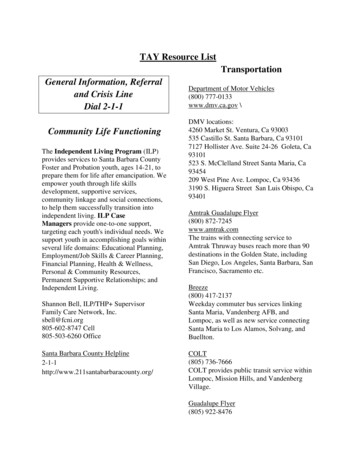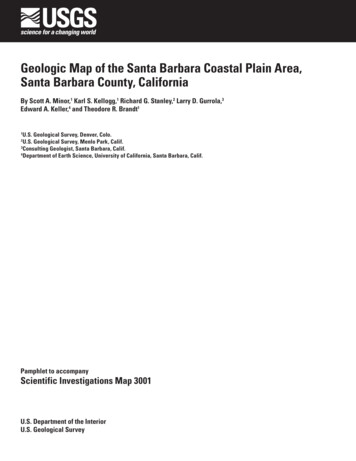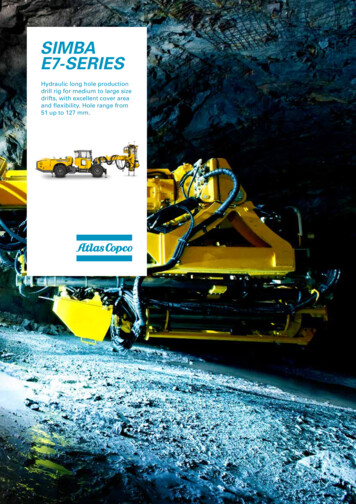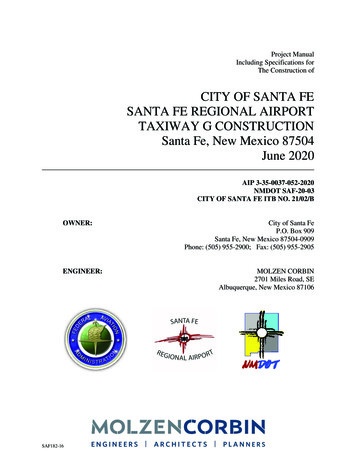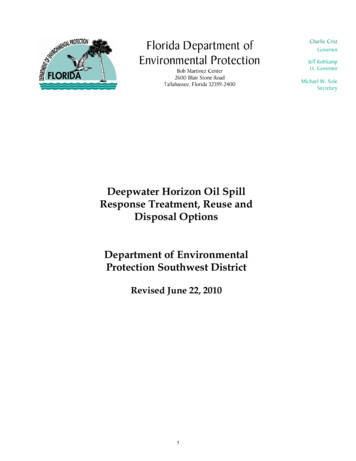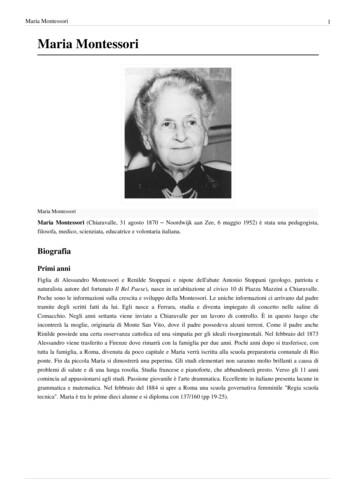
Transcription
TJBulletinHA*- MNo. Q17duQn« / A)Economicberies D Descriptiven,- Geology,nGeology,r1' 9940A\ B,120DEPARTMENT OF THE INTERIORUNITED STATES GEOLOGICAL SURVEYCHARLES D. WALCOTT, DIRECTORPRELIMINARY REPORTON THESANTA MARIA OIL DISTRICTSANTA BARBARA COUNTYCALIFORNIABYRALPH ARNOLD AND ROBERT ANDERSONWASHINGTONGOVEKNMENT PRINTING OFFICE1907
CONTENTS.Page.M* .Introduction.Purpose of this paper.'.Acknowledgments.:.Early history of the district.7779Geography and topography .9Situation .Definition of place names .General topographic features.Geology .Sedimentary formations .General statement.Franciscan formation (Jurassic ?). . .Knoxville formation (lower Cretaceous).Pre-Monterey rocks .:.-.,-.-.Sespe sandstone (Eocene or Oligocene) .Vaqueros formation (lower Miocene).General statement.Lithologic character.Structure and thickness.99101111111112121313]31314.Evidence of age . .15Monterey shale (middle Miocene).General statement.Lower division. .Upper division.Structure and thickness.Evidence of age .Fernando formation (Miocene-Pliocene-Pleistocene).General statement.Lithologic character.Structure .i.Distribution .Evidence of age .Quaternary .General statement.Terrace deposits.Dune sand.'.Alluvium.Igneous rocks.General statement.Pre-Monterey intrusions.Post-Monterey intrusions .151516171919191921232424252525262727272728397354
yCONTENTS.Page.Structure and conditions affecting the presence of oil.General considerations.Region of the San Rafael Mountains .282830Areas of rocks older than the Monterey.Areas of Monterey and later formations.Folds.Faults.Evidence of petroleum.Conclusions regarding future development.Region of the Santa Ynez Mountains .Area south of Lompoc .Area of Santa Rita Hills .Main portion of the Santa Ynez Range.Region between the San Rafael and Santa Ynez mountains .Castnalia Hills and San Antonio terrace.Burton Mesa.:. '. .Purisima Hills .;.Folds.Conclusions regarding future development.Faults and asphalt deposits.Area around Santa Ynez. . .Solomon Hills and area north of Los Olivos. . .General features. .Mount Solomon and associated anticlines ture .,. .40Asphalt deposits .Conclusions regarding future development .Gato Ridge anticline.Structure.Evidence of petroleum.,.Conclusions regarding future development . La Zaca Creek-Lisque Creek anticline.'.:.41424242434444Structure .44Conclusions regarding future development .Summary .of conclusions regarding future development. .Details of the developed territory .Definition of fields.'.Santa Maria field.Contour map.What it shows .Basis.Difficulties of preparation.The eas discussed .Oil zones .Hall-Hobbs-Rice ranch area .Location and structure.'.Geology of the wells.444445454646464646474747474748Product .:.49Pinal-Fox-Hobbs area .49Location and structure.Geology of the wells.'.-.-.4949Product ./--.--.---.--.51
CONTENTS.5Details of the developed territory Continued.'Page.Santa Maria field Continued.The wells Continued.Pinal-Folsom-Santa Maria Oil and Gas-Escolle area.51Location and structure.51Geology of the wells.51Product .'.52Hartnell-Brookshire area .53Location and structure.53Geology of the wells.53Product .54Graciosa-Western Union area .54Location and structure.54Geology of the wells.55Product .55Eastern group of Western Union wells.Location and structure. .--Geology of the wells.Product .Lompocfield. . .Location.Structure.Geology.'.General statement.Burnt shale.Oil zones .The oil.-.-.:.-.Production .Arroyo Grande field.Location.Geology .:. .Structure.Occurrence of the oil .Conclusions regarding future development.Huasna field.Production .Storage capacity.Transportation facilities .5656565757575759595959606060606161616262626363Oil companies. ."i."!. .64Resume .-.'.Index.6567
ILLUSTRATIONS.*Page.PLATE I. Geologic and structural map of the Lompoc and Guadalupe quadrangles, California . PocketII. Structural map of the local Santa Maria oil field-.46FIG. 1. Index map of a part of southern California, showing location of areadiscussed and of other productive oil fields of the State.86.
PRELIMINARY REPORT ON THE SANTA MARIA OILDISTRICT, SANTA BARBARA COUNTY, CAL.By RALPH ARNOLD and ROBERT ANDERSON.INTRODUCTION.PURPOSE OF THIS REPORT.During the last three years the region near the Pacific coast inthe northern part of Santa Barbara County, Cal., has shown promiseof becoming one of the most productive oil fields of the West, if notof the whole United States. The developed fields lie on the low, rolling hills between the Santa Maria and Lompoc valleys, and.the wellsare known to obtain their oil from the Monterey shale, which underlies this region. The lightness of the oil, which averages from 25 to 27 Baume, and the great productiveness of the wells, which yieldan average of 300 to 400 barrels per day, and sometimes as high as3,000 barrels per clay, are among the things for which the districthas become noted. Large areas in the same general region as theproductive fields were known to be analogous, as far as surface evidence went, to the proved territory. With the purpose of studyingthe occurrence of the oil, the extent arid structure of the oil-bearingformations, and their relations to associated formations, the fieldwork leading to the present report was carried on by the writersduring the summer and autumn of 1906. This is a preliminaryreport, and will be followed later by a bulletin containing moredetailed descriptions of the conditions and more complete maps,sections, and other illustrations. The locations of this and other oilfields of southern California are shown in fig. 1.ACKNOWLEDGMENTS.Mr. H. R. Johnson covered the territory northeast of the SantaMaria Valley, and the map and notes concerning that region arelargely the result of his work. Dr. H. W. Fairbanks's paper on thegeology of Point Sal a has been consulted for some of the areal geologyand descriptions of this complicated promontory.« Bull. Dept. Geology, Univ. California, vol. 2, 1806, pp. 1-02.
8SANTA MAETA OIL DISTBICT, CALIFORNIA.Without the assistance of the operators in the developed field thatpart of the report which relates to the geology of the wells, production, and other technical data would have been an impossibility, andthe writers therefore wish to acknowledge their indebtedness to theofficers and managers of the different oil companies for their heartycooperation and support. Thanks are due more particularly to Mr.Area mapped and covered «in this reportAreas already mapped, onvhich reports are now going through the press!Other principal oil-producingregions of the StateCoalinga districtMcKittrick .Midway»SunsetSanta Clara »Santa MariaBakers-field c.Los AngelesPuente HillsSummerland «PIG. 1. Index map of part of southern California, showing location of area discussedand of other productive oil fields of the State.W. W. Orcutt, geologist of the Union Oil Company; Messrs. J. F.Goodwin and F. J. Burns, of the Final and Brookshire oil companies;Mr. Morris. Albee, secretary of the Western Union Oil Company;Mr. Adolph Phillips, of the Graciosa Oil Company; Mr. W. O. Maxwell, of the Recruit Oil Company; Mr. E. E. Henderson, of thePalmer Oil Company; Mr. F. D. Hall, of the Hall & Hall Oil Com-
GEOGRAPHY AND TOPOGRAPHY.9pany; Capt. N. P. Batchelder, of the Los Alamos Oil and Development Company; Mr. Frank M. Anderson, geologist of the SouthernPacific Company; Mr. William Vanderhurst, of the Todos Santos OilCompany; Mr. D. G. Scofield, vice-president of the Standard OilCompany; and many others whose assistance has added materiallyto the value of this report.EARLY HISTORY OF THE DISTRICT.This district was, up to 1899, entirely unknown as an oil-producingterritory. To Messrs. McKay and Mulholland, of Los Angeles, isdue the credit for starting operations in the Santa Maria field proper.After a favorable report had been made on certain lands of the Carreaga ranch, by Mr. Mulholland the Western Union Oil Companywas organized, drilled three prospect holes, and was finally rewarded,in August, 1901, by striking paying quantities of oil in the third well.In 1902 the Final Oil Company, of Santa Maria, began operations onthe north side of Graciosa Ridge and, meeting Avith marked success,Avas folloAved bty the many other companies that have since undertaken operations in this field.GEOGRAPHY A1STB TOPOGRAPHY.SITUATION.The region here discussed is comprised Avithin the Lompoc andGuadalupe quadrangles, as mapped by the United States GeologicalSurvey, AA7hich cover an area of about 1,300 square miles in northernSanta Barbara County, Cal. (See PL I.) It includes portions ofthe San Rafael and Santa Ynez divisions of the Coast Ranges andcovers the basin region between these mountains, Avhich is occupiedby the Santa Maria, Los Alamos, and Santa Ynez valleys and theintervening hill ranges. It is bordered on the Avest and south by thePacific Ocean. The southwest corner of the area is marked by PointArguello and Point Conception, Avhere the coast boAvs around from asoutheast to a Avest-east course. These headlands are among the mostsalient features of the Avhole Pacific coast. The Arroyo Grande oilfield, situated in the San Luis quadrangle to the north, is brieflymentioned in this report.DEFINITION OF PLACE NAMES.The following paragraphs define certain place names as used onthe map (PL I, pocket) and in this report:The only land comprised Avithin the Guadalupe quadrangle is thenarrow strip of coast Avest of longitude 120 30' W. The Lompocquadrangle comprises the rest of the area mapped east of that line.
10SANTA MAEIA OIL DISTEICT, CALIFORNIA.The San Rafael Mountains include the whole group between SantaYnez and Cuyama rivers.The Santa Ynez Mountains include the whole range east of PointArguello between Santa Ynez Eiver and the ocean.The Casmalia Hills include the group extending from the coast atPoint Sal to Graciosa and Harris canyons and San Antonio Valley.The Solomon Hills lie between the Santa Maria Valley, FoxenCanyon, and the Los Alamos Valley and between Divide .and LaZaca Creek.The Purisima Hills lie between Lompoc, the Santa Rita Valley,and the Santa Ynez Valley on the south and the Los Alamos Valleyon the north, and between Burton Mesa on the Avest and Alamo Pintado Creek on the east.The Santa Rita Hills lie between the Santa Ynez and Santa Ritavalleys, extending from a point east of Lompoc nearly to the east edgeof the Santa Rosa grant.The name San Antonio terrace is applied to the wide terracedregion between Casmalia and the west end of the Los Alamos Valley.The Lompoc terrace is the plateaulike region of hills extending"from the coast a distance of about 5 miles east from Honda and thesame distance southeast from Surf.GENERAL TOPOGRAPHIC FEATURES.The San Rafael Range is a high, rugged maze of ridges dividedby steep canyons that usually cut transversely across the formationsregardless of the folding and structural lines. It is traversed bytwo well-graded streams Sisquoc and Cuyama rivers. The rangetrends northwest and southeast, paralleling the main structural linesof California.The Santa Ynez Range has an east-west course and determinesthe long, straight shore line between Point Conception and SantaBarbara. It includes a long, even-topped ridge rising abruptly fromthe sea and a hilly belt between this ridge and the Santa Ynez Valley.Its topography reflects the structure more than that of the San RafaelMountains and deformation within it does not appear to have goneso far as in that range.The triangular hilly basin opening out toward the coast betweenthese two divergent ranges of mountains contains three main valleysand several lines of higher ground that radiate like the ribs of afan from the vertex of the triangle. The point of especial interestin the topography of these interior features is their characteristicreflection of the structure of the formations. They contrast in thisrespect with the two boundary ranges just mentioned.
SEDIMENTARY FORMATIONS.11An anticline in this intermediate region is apt to be marked by aridge, as in the long ridges of the Purisima Hills, which follow closeto the axis of a broad anticline; and some of the larger valleys coincide Avith the synclinal axes of the broad lines of structure. Thelatter statement is illustrated by the Santa Ynez Valley in parts andby its structural although not actual continuation in the Santa RitaValley. It is also exemplified by the upper portion of the LosAlamos Valley and by Harris Canyon. These topographic featuresmay be explained by the fact that the main movements in these hillranges have been gentle as compared with those in the older mountain masses, that the disturbances giving them form have been comparatively recent, and that deformation has not gone very far. Lowareas of rolling hills are almost sure to prove that a syncline orplunging fold has given rise to structural depressions in whichdeposits of soft sand, producing low topographic forms, have beenlaid down.GEOLOGY.SEDIMENTARY FORMATIONS.GENERAL STATEMENT.The formations involved in the geology of this district include theFranciscan (Jurassic?), Knoxville (lower Cretaceous), pre-Monterey(which may include both Cretaceous and older Tertiary), Sespc(Eocene or Oligocene), Vaqueros (lower Miocene), Monterey (middle Miocene), Fernando (Miocene-Pliocene-Pleistocene), and otherQuaternary deposits.FRANCISCAN FORMATION (JURASSIC?).The oldest rocks within the Santa Maria district belong to the formation described by Fairbanks a under the name San Luis, and areprobably of Jurassic age. They represent the Franciscan formation,which is a very important basement formation in the Coast Rangesfarther north. The small areas of these rocks occurring here consistof remnants of sandstone, shale, glaucophane schist, and jasper, associated with serpentine that has probably been intrusive in them. Thesandstone is in general of a dark-green color, fairly fine grained, andconsiderably indurated. The jasper is banded by thin contorted beds.These sediments are so disturbed that little clue as to their structurecan be obtained and so local in extent that no attempt has been madein mapping to differentiate them from the accompanying serpentine.n Fairbanks, H. W., 'Description of the San Luis quadrangle: Geologic Atlas U. S.,'.folio 101, U. S. Geol. Survey, 1904.
12SANTA MARIA OIL DISTRICT, .CALIFORNIA.KNOXVILLE FORMATION (LOWER GRETACEOUS).Several small areas of sedimentary rock occur, which can be definitely assigned on fossil evidence to the Knoxville formation (lowerCretaceous). The two most important are north of Mount Lospe, inthe Casmalia Hills. The rock is chiefly dark-colored, unaltered argillaceous shale such as is characteristic of the Knoxville throughout itswide area of distribution in the California Coast Ranges. Sandstoneand conglomerate occur in lesser amounts. Brownish-yellow sandstone, similar to that common in the Knoxville in the Coast Rangesseveral hundred miles farther north, occurs on the border of an irregular area of diabase on Tepusquet Creek in the San Rafael Mountainsand contains Knoxville fossils. It is present onry in very smallpatches and seems to have been brought up from below by the diabaseintrusion. Knoxville rocks were recognized in one other place in theSan Rafael Mountains, a few miles north of Zaca Lake, at the baseof the series mapped as pre-Monterey. It is very likely that a portion of the area so mapped belongs to the lower Cretaceous, but it isnot probable that the whole does. The differentiation of the formations included within these two areas has been left for later work.PRE-MONTEREY ROCKS.Two large areas of sedimentary rocks, whose age has not been determined otherwise than that they are older than the Monterey, occurin the San Rafael Mountains. It is probable that strata of Knoxville (lower Cretaceous) age occur at the base of the series in theseareas and that the higher portions represent either the upper Cretaceous or the Eocene, or both, and possibly include some Vaqueros.Detailed work Avas left until another time.The larger of these two areas occupies the northeast corner of theterritory and has an extent of about 60 square miles. The other lieson the northeastern slope of the high ridge north of Zaca Lake. Inthese areas is exposed a great series of thin-bedded, dark-colored,locally greenish shale alternating with more massively bedded sandstone that is in places of a very granitic nature. Conglomerate,much of it plainly showing its origin from granite, occurs in minorhorizons. Knoxville fossils were found in a gritty greenish sandstone near the lowest portion of these pre-Monterey rocks, about 2miles north of Zaca Lake, and it is probable that a considerable portion of the series is lower Cretaceous. The higher portion seems tobe a continuation of a formation in San Luis Obispo County that hasbeen considered upper Cretaceous and of one in southeastern SantaBarbara County that has been ascribed,to the Eocene. Its age istherefore much in doubt. It may also include at the top a part of
SEDIMENTARY FORMATIONS.13the Vaqueros (lower Miocene), which overlies this doubtful terraneand of which the base has not been definitely determined.Structurally the strata included in the pre-Monterey rocks liebeneath the Monterey and upper Vaqueros, but though far older theydo not bear the marks of intense folding as strongly as the brittleMonterey shale. They are, however, steeply upturned, and the linesof folding, as in the other formations, have in .general a northwestsoutheast direction.SESPE SANDSTONE (EOCENE OR OLIGOCENE).The Sespe sandstone, of Eocene or Oligocene age, which.is of greatimportance farther east, notably in the region of the Summerland oildistrict near Santa Barbara, appears in this territory, so far as discovered, only at a point about 4 miles south of the Santa Ynez Mission,where the deep-red sandstone characteristic of this formation, outcrops very locally in the axis of the central anticline of the SantaYnez Range, conformably underlying sandstone of the Vaqueros(lower Miocene). It is probable that this formation has a wideextent in the Santa Ynez Range under the beds of the lower Miocene,although it is not elsewhere exposed.VAQUEROS FORMATION(LOWER MIOCENE).rGENERAL STATEMENT.The Miocene was a period of almost, if not absolutely, continuousmarine deposition in this- region, and the sedimentary beds of thisage predominate over all others in thickness and areal extent. TheVaqueros comprises the lower Miocene and overlies conformably thered sandstone at the top of the Sespe (Eocene or Oligocene). Itseems to cover most of that part of the Santa Ynez Range which isincluded within the Lompoc and Guadalupe quadrangles, althoughit must be stated that this range was not examined in sufficient detailto warrant definite sweeping statements.0 It also covers belts in theSan Raf ael Mountains, where it is exposed at the base of the Monterey(middle Miocene).LITHOLOGIC CHARACTER.The lower portion of the Vaqueros is made up of a thick series ofgreenish-gray, coarse and fine sandstone, much of it somewhat concretionary in character, interbedded with dark, fine-grained, thin-beddeda Since writing this report paleontological evidence indicating the Eocene age (equivalent to the Tejon formation) of the sandstone beneath the fossiliferous Vaqueros conglomerate has been discovered. It should be borne in mind, therefore, that a considerableportion, at least, of the terrane described and mapped in this paper as Vaqueros is ofTejon (Eocene) age.
14SANTA MAEIA OIL DISTEIOT, CALIFOENIA.shale in lesser amount. Toward the middle of the formation theshale increases in amount, alternating with thin beds of sandstone.For considerable thicknesses the shale has a characteristic olive-graycolor, and owing to its hard, gritty, brittle nature makes excellentroad material for the Santa Ynez Valley. The shale and sandstonecontinue up to the top of the Vaqueros, giving place in large part,however, to other deposits of shallow-water character, such as coarsesandstone and a great quantity of coarse, in places greenish or reddish, gravelly conglomerate. 6 At the top of the formation there is aconformable gradation into the Monterey (middle Miocene) beds, thesummit of the Vaqueros being marked in many places by a calcareouszone, as, for instance, south of Lompoc, where the two formations aredivided by a very prominent bed of hard limestone. Sandstone,shale, and conglomerate that probably belong to the Vaqueros occurat the seaward end of the Casmalia Hills. They constitute a portionof a formation conformably underlying the Monterey, but separatedfrom beds of flint and shale that can be definitely assigned to thatformation by many hundred feet of soft, light-brown, clayey, alkaline shale that is almost invariably full of crystalline gypsum. Theconditions which existed here during the period of transition fromtypical Vaqueros to typical Monterey sedimentation must have beenvery different from those which prevailed over the areas occupied bythe Santa Ynez and San Bafael ranges.STRUCTURE AND THICKNESS.Like all the Tertiary and pre-Tertiary formations of this region,the Vaqueros has been subjected to folding that has left little of it inan undisturbed attitude. But owing to the character of the deposits,which are in large part soft sandstone and conglomerate with interbedded layers of sandstone and clayey shale, the strata have not beenso violently fractured and disturbed as much of the brittle shale ofthe lower portion of the Monterey. A marked instance of the way inwhich the soft, coarse conglomerate has been left little affected occursin Buckhorn Canyon, where thick beds of it, probably part of theVaqueros, lie almost horizontal.The high ridge of the Santa Ynez Mountains from Point Conception eastward is formed by a great monocline of sandstone of supposed Vaqueros age, that dips toward the sea on the south at anangle of about 25 . North of this ridge occurs a longitudinal depression in the range in which the folds of the Vaqueros are fairly low,and still farther north, bordering the Santa Ynez Valley, these rocksare considerably disturbed, dipping in various directions and at allangles between 20 or 30 and the vertical. In the San Rafael6 This conglomerate is believed to mark the base of the lower Miocene (true Vaqueros).
SEDIMENTAEY FORMATIONS.15Mountains the strata of this age are steeply folded along northwestsoutheast lines, in conformity with the overlying Monterey.The formation that has been taken to be entirely Vaqueros in theSanta Ynez Mountains has a thickness of at least 5,000 feet,a and. further work may allow the figures to be considerably increased.EVIDENCE OF AGE.Characteristic fossils are abundant in the limestone at the top ofthe Vaqueros, and in beds of the conglomerate and sandstone in theupper part of the formation, but occur sparingly in the lower half.Those in the conglomerate near the top include huge oysters, pectens,and turritellas that show in the size and strength of their shellsremarkable adaptation to the conditions prevailing in the shallowwater where the big boAvlders of the conglomerate were being tumbledabout and deposited. These fossils are such as are distinctive of theVaqueros throughout the coast ranges and afford good evidence ofits lower Miocene age. Only a few feet conformably below the conglomerate containing the characteristic Vaqueros lower Miocene faunais sandstone containing typical Tejon (Eocene) fossils. So far asknown, no species bridges the gap between the two faunas, eitherhere or elsewhere in California where similar stratigraphic relationsof the two formations have been observed.MONTEREY SHALE(MIDDLE MIOCENE).GENERAL STATEMENT.A great series of fine shales, largely of organic origin, overliesconformably the coarse and fine sedimentary deposits of the Vaquerbs.These shales make up the Monterey formation and are representativeof the'whole of middle Miocene time. The formation is of greatthickness and is doubly important as the probable source and thepresent reservoir of the oil. The areal extent of the Monterey is notadequately represented on the map. It doubtless covers as one continuous sheet the whole basin between the Santa Ynez and San Rafaelmountains as well as a large part of these ranges, but it is coveredover considerable areas by later deposits, which are in many placesvery thin. The character, structure, and relations of
PRELIMINARY REPORT ON THE SANTA MARIA OIL DISTRICT, SANTA BARBARA COUNTY, CAL. By RALPH ARNOLD and ROBERT ANDERSON. INTRODUCTION. PURPOSE OF THIS REPORT. During the last three years the region near the Pacific coast in the northern part of Santa Barbara County, Cal., has shown promise
